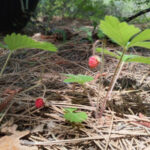Strawberry Fields Forever
In the heart of the Herland Forest, in what we think of as the “middle forest”, there’s a syncline that channels runoff from the watershed forest north of the cemetery. One result is that the moist forest floor is carpeted with wild strawberry plants.
These aren’t the huge strawberries that you see in modern markets; instead they’re more the size of blueberries, and have a more concentrated flavor. For the Haudenosaunee (aka the “Iroquois”), these were the key ingredient in a therapeutic tonic developed by Handsome Lake, the Senneca shaman who used wild strawberries like these to counter the debilitating impact of alcohol on his people.
 At the boundary between Herland’s middle and western forests you’ll find a patch of spreading dogbane. In early summer, it’s alive with huge butterflies feasting on the nectar it provides.
At the boundary between Herland’s middle and western forests you’ll find a patch of spreading dogbane. In early summer, it’s alive with huge butterflies feasting on the nectar it provides.
Dogbane is a medicinal herb that can be used to treat a variety of conditions, but like most medicines, it can be toxic if used improperly. One of dogbane’s traditional uses is to produce “wood cotton”, a soft, strong fiber similar to linen.
The vision behind Herland Forest involves creating a living memorial. A key part of that involves getting to know the history and future of the plants that make up the Herland Forest. Your interest and support make this work possible.
Thank you.

